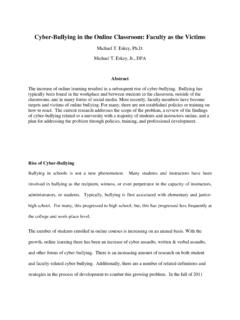Transcription of Philosophies and Swing Concepts - NEPGA Assistants
1 Philosophies and Swing Concepts Activity I Putting 1. It is the mechanical requirements that separate the poor from the great putters. (True/False) False 2. To be a successful putter one must also be able to do what? Have the ability to judge slope, the sensitivity to feel the proper speed, and the courage to act on his decision 3. To produce a successful putt, one must do what? Roll the ball on the correct path and do so at the right speed 4. These two requirements are the same for all golf shots. (True/False) True 5. The most common putting grip is what? Reverse overlap 6. The most difficult and most important element in the mechanics of putting? Aiming accurately 7. In anticipation of contract with the ball, or fear of missing the putt, this happens? Deceleration 8. The fear of missing putts comes from what? Remembering missed putts 9. The SLOWER the green, the _____ loft needed.
2 More 10. The FASTER the green, the _____ loft needed. Less 11. The average loft of a putter? Four Degrees 12. The player s hand position also affects loft. (True/False) True 13. If the grain is going away, the grass looks _____, and the putt will be _____? Shiny & Fast 14. If the grain is coming toward, the grass looks _____, and the putt will be _____? Dull & Slow TRUE/FALSE 15. To reduce confusion, the student should use the same grip as used in the full Swing . False 16. The advantage of the cross-handed grip is that the left wrist is less likely to collapse in the forward stroke. True 17. A good way to see if the weight is focused and stabilized on the left foot is raise the right foot. True 18. A pendulum stroke is a stroke of equal length both back and through, club opens slightly at beginning and squares at impact.
3 True The 7 Principles of Good Putting 1. Eye-line over or slightly inside the ball 2. Clubface square to the target 3. Position square to the target 4. Keep body motion limited 5. Use an accelerating stroke 6. Be comfortable 7. Make solid contact by hitting the ball in the sweet spot . Activity II Chipping and Pitching 1. A PITCH has _____ air time and _____ ground time. More, Less 2. A CHIP has _____ air time and _____ ground time. Less, More 3. An important factor in distinguishing the difference between a chip and pitch. Trajectory 4. Chips are usually _____-wristed with _____-lever strokes Firm, One 5. Pitches are more _____ of the wrists and hands to create a ____ lever. Cocking, 2nd 6. Better players tend to chip or pitch from a full grip length position. (T/F) False 7. Moving the grip portion of the club back adds loft, while moving it forward reduces it.
4 True **Putt when you can, chip when you can t putt, pitch only when you have to** 9 Basic Questions about Chipping 1. What is the difference between the putt and the chip in how one places their feet? In the chip, the stance is open with feet closer together 2. Why is the stance open for the chip? The stance is open b/c this makes it easier to sense the target line and Swing the club back closer to this line. 3. Where are one s hands placed on the grip to play a chip shot? Hand placement should be farther down the club, shortened. 4. Why are one s hands further down on the grip? Hands are lower on the club for control. 5. In the chip where is the emphasis in the placement of the lower-body? Weight should be over the left foot. 6. Where does the upper body s vertical centerline fall in the chip? The upper body s vertical center line should fall two inches in front of the ball.
5 7. In the chip, where are the hands in relation to the club head at address? Hands are slightly forward at address 8. Why are the hands placed this way? So the low point of the Swing arc will be reached after the ball contact rather than before. This helps guarantee a center-face impact. Having the weight on the left and the centerline ahead of the ball, also promotes descent. 9. Is the stroke made with wrists hinging and hands active or wrists firm and hands quiet? The basic chip is one-lever stroke with the wrists and hands quiet and the arms swinging from the shoulders. The Basic Pitch When making the transition from chip to pitch, the student faces a psychological change, the club used is a high lofted club and the student will have the tendency to cock the wrists early to try and lift the ball in the air. Chip = Arms back, Arms Through Pitch = Hands & Arms Back, Arms Through 1.
6 Distance control on short shots will be determined largely by what? Club head speed 2. Which in turn is influenced mostly by what? The length of the back Swing 3. The 5-Step routine for distance on chips and pitches. Survey, Visualize, Rehearse, Execute, Evaluate Activity III Bunker Play 3 Characteristics which make the sole of the sand wedge work 1. Sole inversion 2. Camber 3. Breadth 8 Principles involved in a greenside bunker shot with the ball sitting up 1. Establish a firm footing that will support the Swing without slipping 2. Take an open stance to restrict backswing length and steepen the Swing 3. Open the clubface to match the address position 4. Start with the weight favoring the left side at address for the normal shot 5. Swing the club like a full cut pitch shot matching the length of backswing and follow-through to the force needed for that shot.
7 6. Strike the sand 2-4 inches behind the ball 7. Do not let the face close until after impact 8. Continue to accelerate through the ball to a natural finish 4 Principles for buried bunker shots 1. Play the ball further back in the stance to get more penetration with the club face 2. If buried deeply, turn the toe in to make a knife-like leading edge for entry 3. Accelerate well into impact 4. Consider using a 9-iron or PW for buried shots where a longer distance is required 1. What should one do to execute a soft bunker shot and protect the toe of the club from passing the heel? Rotate the left hand counterclockwise to an open-faced position before placing it on the grip 2. When the clubface is opened more _____ is created, giving increased ____ to the sole. Inversion, bounce 3. If the pupil tends to close the face at impact & did excessively, then which aiming principle should be employed?
8 Aim left, open face, steep Swing across the target line method 4. What causes the ball s direction when leaving the sand? Combination of path and face 5. Since the sand will slow the clubface, which will influence the ball direction more? Face 6. In a greenside bunker, the player should contact the _____ first. Sand 7. In a fairway bunker, the player should contact the _____first. Ball 8. The hardest thing for students to overcome? Fear of bunker shot 9. Much of a player s success in the bunker depends on what? Confidence 10. Good Swing thought for fairway bunker shots Below its equator, but above the sand V Shaped Swing - early pronounced wrist cock to get steepness, pops ball higher, softer, and shorter U Shaped Swing - Swing that resembles a normal pitch shot 5 Ways to control distance in the bunker shot 1. Angle of Approach- Steep angle for short distances, shallow angle for longer distance 2.
9 Blade Position- Add loft by opening blade, Decrease loft by closing blade 3. Back Swing Length and Pace 4. Amount of Sand- Shorter shots take more sand, longer shots take less sand 5. Length of follow-through 8 Essentials for a successful pitch or chip 1. Shorten down on the grip for greater control 2. Grip pressure may be firm or light but NEVER tight. Why? Because tightness destroys touch 3. The feet and hips are open to the target. Why? Causes the backswing to be more on target line, restricts backswing length for more control 4. The stance is narrower than in a full shot. Why? Encourages player to have weight more on left foot, also avoids shifting weight to right side 5. The ball is played in the center of the stance for normal chips and pitches 6. A vertical line drawn down the center of the body, splitting it in half, would fall a couple of inches to the left of the ball on a standard chip and fall directly on the ball with a standard pitch 7.
10 Arms hang comfortably from the shoulders 8. These shots require POSITIVE acceleration to and through the ball Specialty Shots 1. A high shot played primarily with a long, slow-paced arm Swing and very little hand action Lob Shot 2. A wristy pitch used when a very soft landing is needed Flop Shot 3. A shot struck with a slightly open clubface where the clubhead path is traveling left of target. Cut Shot 4. A firm-wristed pendulum stroke where the club is held almost vertically so the grip is more across the palms than normal. Off-green putt style True/False 1. For buried greenside bunker shots, a full follow-through is vital in sustaining force. False 2. In bunker play, a closed-grip will make it difficult to execute a splash sand shot. True 3. With an open stance, the student will find it easier to restrict backswing length and steepen the Swing .







